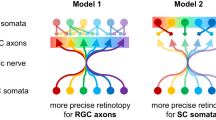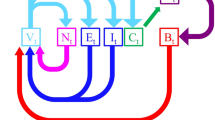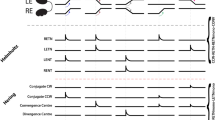Abstract
Blockade of retinal waves prevents the segregation of retinogeniculate afferents into eye-specific layers in the visual thalamus. However, the key features of retinal waves that drive this refinement are controversial. Some manipulations of retinal waves lead to normal eye-specific segregation but others do not. By comparing retinal spiking patterns in several mutant mice with differing levels of eye-specific segregation, we show that the presence of high-frequency bursts synchronized across neighboring retinal ganglion cells correlates with robust eye-specific segregation and that the presence of high levels of asynchronous spikes does not inhibit this segregation. These findings provide a possible resolution to previously described discrepancies regarding the role of retinal waves in retinogeniculate segregation.
This is a preview of subscription content, access via your institution
Access options
Subscribe to this journal
Receive 12 print issues and online access
$209.00 per year
only $17.42 per issue
Buy this article
- Purchase on Springer Link
- Instant access to full article PDF
Prices may be subject to local taxes which are calculated during checkout







Similar content being viewed by others
References
Shatz, C.J. & Stryker, M.P. Prenatal tetrodotoxin infusion blocks segregation of retinogeniculate afferents. Science 242, 87–89 (1988).
Penn, A.A., Riquelme, P.A., Feller, M.B. & Shatz, C.J. Competition in retinogeniculate patterning driven by spontaneous activity. Science 279, 2108–2112 (1998).
Rossi, F.M. et al. Requirement of the nicotinic acetylcholine receptor beta 2 subunit for the anatomical and functional development of the visual system. Proc. Natl. Acad. Sci. USA 98, 6453–6458 (2001).
Stellwagen, D. & Shatz, C.J. An instructive role for retinal waves in the development of retinogeniculate connectivity. Neuron 33, 357–367 (2002).
Huberman, A.D. et al. Eye-specific retinogeniculate segregation independent of normal neuronal activity. Science 300, 994–998 (2003).
Godement, P., Salaun, J. & Imbert, M. Prenatal and postnatal development of retinogeniculate and retinocollicular proejctions in the mouse. J. Comp. Neurol. 230, 552–575 (1984).
Muir-Robinson, G., Hwang, B.J. & Feller, M.B. Retinogeniculate axons undergo eye-specific segregation in the absence of eye-specific layers. J. Neurosci. 22, 5259–5264 (2002).
Huberman, A.D., Stellwagen, D. & Chapman, B. Decoupling eye-specific segregation from lamination in the lateral geniculate nucleus. J. Neurosci. 22, 9419–9429 (2002).
Grubb, M.S., Rossi, F.M., Changeux, J.P. & Thompson, I.D. Abnormal functional organization in the dorsal lateral geniculate nucleus of mice lacking the beta 2 subunit of the nicotinic acetylcholine receptor. Neuron 40, 1161–1172 (2003).
Butts, D.A. Retinal waves: implications for synaptic learning rules during development. Neuroscientist 8, 243–253 (2002).
Katz, L.C. & Shatz, C.J. Synaptic activity and the construction of cortical circuits. Science 274, 1133–1138 (1996).
Ruthazer, E.S. & Cline, H.T. Insights into activity-dependent map formation from the retinotectal system: a middle-of-the-brain perspective. J. Neurobiol. 59, 134–146 (2004).
Mooney, R., Penn, A.A., Gallego, R. & Shatz, C.J. Thalamic relay of spontaneous retinal activity prior to vision. Neuron 17, 863–874 (1996).
McLaughlin, T., Torborg, C.L., Feller, M.B. & O'Leary, D.D. Retinotopic map refinement requires spontaneous retinal waves during a brief critical period of development. Neuron 40, 1147–1160 (2003).
Singer, J.H., Mirotznik, R.R. & Feller, M.B. Potentiation of L-type calcium channels reveals nonsynaptic mechanisms that correlate spontaneous activity in the developing mammalian retina. J. Neurosci. 21, 8514–8522 (2001).
Guldenagel, M. et al. Expression patterns of connexin genes in mouse retina. J. Comp. Neurol. 425, 193–201 (2000).
Sohl, G., Guldenagel, M., Traub, O. & Willecke, K. Connexin expression in the retina. Brain Res. Brain Res. Rev. 32, 138–145 (2000).
Deans, M.R., Gibson, J.R., Sellitto, C., Connors, B.W. & Paul, D.L. Synchronous activity of inhibitory networks in neocortex requires electrical synapses containing connexin36. Neuron 31, 477–485 (2001).
Deans, M.R., Volgyi, B., Goodenough, D.A., Bloomfield, S.A. & Paul, D.L. Connexin36 is essential for transmission of rod-mediated visual signals in the mammalian retina. Neuron 36, 703–712 (2002).
Meister, M., Pine, J. & Baylor, D.A. Multi-neuronal signals from the retina: acquisition and analysis. J. Neurosci. Methods 51, 95–106 (1994).
Demas, J., Eglen, S.J. & Wong, R.O. Developmental loss of synchronous spontaneous activity in the mouse retina is independent of visual experience. J. Neurosci. 23, 2851–2860 (2003).
Torborg, C.L. & Feller, M.B. Unbiased analysis of bulk axonal segregation patterns. J. Neurosci. Methods 135, 17–26 (2004).
Bansal, A., Singer, J.H., Hwang, B. & Feller, M.B. Mice lacking specific nAChR subunits exhibit dramatically altered spontaneous activity patterns and reveal a limited role for retinal waves in forming ON/OFF circuits in the inner retina. J. Neurosci. 20, 7672–7681 (2000).
Meister, M., Wong, R.O., Baylor, D.A. & Shatz, C.J. Synchronous bursts of action potentials in ganglion cells of the developing mammalian retina. Science 252, 939–943 (1991).
Wong, R.O., Meister, M. & Shatz, C.J. Transient period of correlated bursting activity during development of the mammalian retina. Neuron 11, 923–938 (1993).
Stellwagen, D., Shatz, C.J. & Feller, M.B. Dynamics of retinal waves are controlled by cyclic AMP. Neuron 24, 673–685 (1999).
Ruthazer, E.S., Akerman, C.J. & Cline, H.T. Control of axon branch dynamics by correlated activity in vivo. Science 301, 66–70 (2003).
Zoli, M., Lena, C., Picciotto, M.R. & Changeux, J.P. Identification of four classes of brain nicotinic receptors using beta2 mutant mice. J. Neurosci. 18, 4461–4472 (1998).
Grubb, M.S. & Thompson, I.D. Visual response properties in the dorsal lateral geniculate nucleus of mice lacking the beta2 subunit of the nicotinic acetylcholine receptor. J. Neurosci. 24, 8459–8469 (2004).
Long, M.A., Deans, M.R., Paul, D.L. & Connors, B.W. Rhythmicity without synchrony in the electrically uncoupled inferior olive. J. Neurosci. 22, 10898–10905 (2002).
Buhl, D.L., Harris, K.D., Hormuzdi, S.G., Monyer, H. & Buzsaki, G. Selective impairment of hippocampal gamma oscillations in connexin-36 knock-out mouse in vivo. J. Neurosci. 23, 1013–1018 (2003).
Bear, M.F. A synaptic basis for memory storage in the cerebral cortex. Proc. Natl. Acad. Sci. USA 93, 13453–13459 (1996).
Bi, G. & Poo, M. Synaptic modification by correlated activity: Hebb's postulate revisited. Annu. Rev. Neurosci. 24, 139–166 (2001).
Birtoli, B. & Ulrich, D. Firing mode-dependent synaptic plasticity in rat neocortical pyramidal neurons. J. Neurosci. 24, 4935–4940 (2004).
Chapman, B. Necessity for afferent activity to maintain eye-specific segregation in ferret lateral geniculate nucleus. Science 287, 2479–2482 (2000).
Wang, G.Y., Ratto, G., Bisti, S. & Chalupa, L.M. Functional development of intrinsic properties in ganglion cells of the mammalian retina. J. Neurophysiol. 78, 2895–2903 (1997).
Acknowledgements
We thank E.J. Chichilnisky for the multielectrode array and technical support, D. Paul for the Cx36−/− mice, J. Goldstein and W. Pak for technical support, and D.E. Feldman, N. Spitzer and L. Boulanger for a critical reading of this manuscript. Supported in part by a US National Science Foundation Graduate Research Fellowship, the Klingenstein Foundation, Whitehall Foundation, March of Dimes, McKnight Scholars Fund and the National Institutes of Health (grant number NS13528-01A1).
Author information
Authors and Affiliations
Corresponding author
Ethics declarations
Competing interests
The authors declare no competing financial interests.
Supplementary information
Supplementary Fig. 1
Correlation index does not change as a function of bin size. Correlation index was computed as previously stated for binwidths from 10 ms to 500 ms. (GIF 21 kb)
Supplementary Fig. 2
β-galactosidase expression in the developing dLGN. Both Cx36–/– (top row) and Cx36+/– (bottom row) dLGNs reveal a transient expression of β-gal throughout development. Scale = 100 µm. Insets: β-gal expression is localized to somata within the dLGN. Scale = 5 µm. The existence of Cx36 in the dLGN cannot account for our results since eye–specific segregation was normal in Cx36–/– mice. (JPG 43 kb)
Supplementary Fig. 3
Cell-attached recording of a single burst from a P10 Cx36–/– RGC indicates spike adaptation occurs in RGCs. Recordings were made from acutely isolated Cx36–/– retinas perfused with oxygenated ACSF and warmed to 32-35° C. The internal electrode solution contained (in mM): 98.3 potassium gluconate, 1.7 KCl, 0.6 EGTA, 5 MgCl2, 2 Na2-ATP, 0.3 GTP, and 40 HEPES, pH 7.25, with KOH. Voltage-clamp cell-attached recordings were made using an Axopatch 200B amplifier and pClamp6 software (Axon Instruments, Foster City, CA). (GIF 9 kb)
Supplementary Video 1
Time-Lapse Representation of Firing Rates Recorded in Wild-Type and Cx36–/– Retinal Neurons Using a Multielectrode Array For each movie, dots represent the positions of electrodes in the multielectrode array on which discreet units were recorded. The size of each dot in every frame represents the average firing rate recorded over 500 ms on that electrode, larger dots correspond to higher firing rates. The movie plays at 10 frames/s (i.e., five times as fast as real time) and represents five minutes of recording. Only electrodes in which unambiguous units could be isolated from each other are illustrated. If multiple units were recorded on the same electrode, units were randomly eliminated so only one unit was portrayed on each electrode. (MOV 625 kb)
Supplementary Video 2
Time-Lapse Representation of Firing Rates Recorded in Wild-Type and Cx36–/– Retinal Neurons Using a Multielectrode Array For each movie, dots represent the positions of electrodes in the multielectrode array on which discreet units were recorded. The size of each dot in every frame represents the average firing rate recorded over 500 ms on that electrode, larger dots correspond to higher firing rates. The movie plays at 10 frames/s (i.e., five times as fast as real time) and represents five minutes of recording. Only electrodes in which unambiguous units could be isolated from each other are illustrated. If multiple units were recorded on the same electrode, units were randomly eliminated so only one unit was portrayed on each electrode. (MOV 734 kb)
Supplementary Video 3
Time-Lapse Representation of Firing Rates Recorded in Wild-Type and Cx36–/– Retinal Neurons Using a Multielectrode Array For each movie, dots represent the positions of electrodes in the multielectrode array on which discreet units were recorded. The size of each dot in every frame represents the average firing rate recorded over 500 ms on that electrode, larger dots correspond to higher firing rates. The movie plays at 10 frames/s (i.e., five times as fast as real time) and represents five minutes of recording. Only electrodes in which unambiguous units could be isolated from each other are illustrated. If multiple units were recorded on the same electrode, units were randomly eliminated so only one unit was portrayed on each electrode. (MOV 684 kb)
Supplementary Video 4
Time-Lapse Representation of Firing Rates Recorded in Wild-Type and Cx36–/– Retinal Neurons Using a Multielectrode Array For each movie, dots represent the positions of electrodes in the multielectrode array on which discreet units were recorded. The size of each dot in every frame represents the average firing rate recorded over 500 ms on that electrode, larger dots correspond to higher firing rates. The movie plays at 10 frames/s (i.e., five times as fast as real time) and represents five minutes of recording. Only electrodes in which unambiguous units could be isolated from each other are illustrated. If multiple units were recorded on the same electrode, units were randomly eliminated so only one unit was portrayed on each electrode. (MOV 1266 kb)
Rights and permissions
About this article
Cite this article
Torborg, C., Hansen, K. & Feller, M. High frequency, synchronized bursting drives eye-specific segregation of retinogeniculate projections. Nat Neurosci 8, 72–78 (2005). https://doi.org/10.1038/nn1376
Received:
Accepted:
Published:
Issue Date:
DOI: https://doi.org/10.1038/nn1376
This article is cited by
-
The endogenous neuronal complement inhibitor SRPX2 protects against complement-mediated synapse elimination during development
Nature Neuroscience (2020)
-
Homeostatic plasticity in neural development
Neural Development (2018)
-
Monocular enucleation alters retinal waves in the surviving eye
Neural Development (2018)
-
Tectal-derived interneurons contribute to phasic and tonic inhibition in the visual thalamus
Nature Communications (2016)
-
Resting electrical network activity in traps of the aquatic carnivorous plants of the genera Aldrovanda and Utricularia
Scientific Reports (2016)



